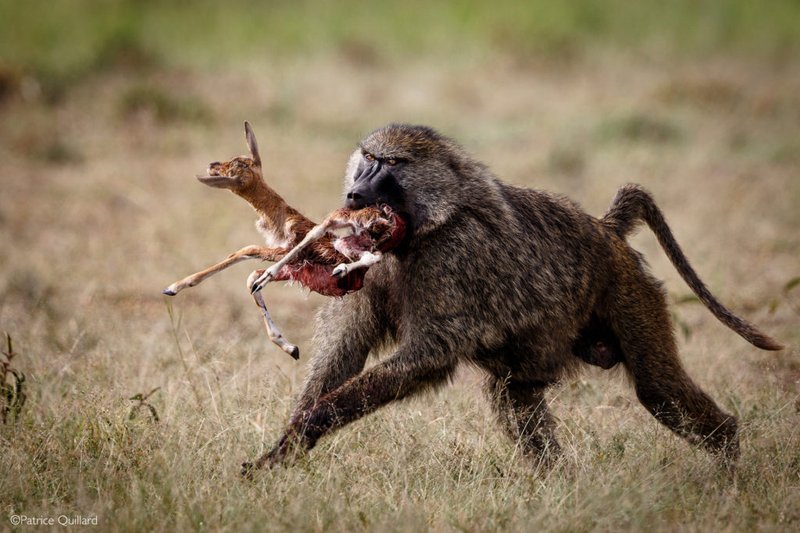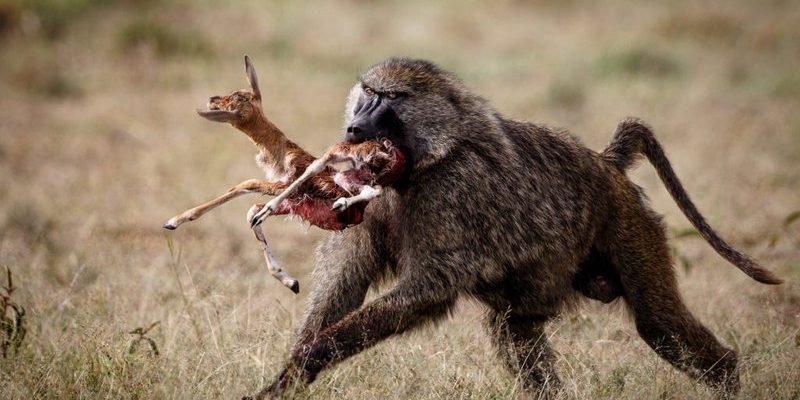
When you picture a baboon, what comes to mind? Maybe it’s their vibrant faces and social behavior that grip your attention. Here’s the thing: their survival heavily relies on their ability to scavenge and hunt effectively. While they might not look like your typical apex predator, baboons have some unique tricks up their sleeves. From the types of food they prefer to how they work together to find meals, let’s dive into the dietary habits and hunting strategies of these remarkable primates.
What Do Baboons Eat?
Baboons are omnivores, which means they eat a variety of foods. Their diet can be quite diverse, including fruits, seeds, leaves, and insects. Depending on their habitat, they adapt efficiently to whatever’s available. Imagine heading to a buffet filled with different cuisines; baboons do something similar in their natural environment.
- Fruits: Baboons love fruits like apples, berries, and grapes. They often munch on whatever is seasonal, which helps them get the nutrients they need.
- Vegetation: They also enjoy leaves and grasses. In tough times, they might even resort to the bark of trees.
- Insects: Insects such as grasshoppers and crickets are classic protein sources for baboons. Think of them as the baboon version of a protein bar!
In the wild, the availability of food can change with the seasons. Baboons have a remarkable skill for locating edible items, often using their keen sense of sight and memory to return to fruitful spots. They’re not just scavenging; they’re strategizing about where to find their next meal.
Baboons and Foraging Behavior
Foraging is a critical activity for baboons, and they have some interesting methods for pulling it off. Picture a group of friends planning a picnic: they strategize about where to go and what to bring. Baboons do something similar when it comes to gathering food.
They often work in groups, using their social bonds to help each other out. For example, some baboons might scout ahead for ripe fruits while others hang back, keeping watch for predators. This teamwork is vital, as it allows them to maximize their foraging success while minimizing risk.
Baboons also use their intelligence to assess the best times to search for food. They know that during certain hours, like early morning or late afternoon, there are fewer predators around, making it safer to venture out. It’s all about planning and timing!
Hunting Strategies of Baboons
While baboons primarily forage, they are also known to hunt small animals. It’s important to note that baboons don’t typically go after larger prey, but they can be opportunistic hunters when the chance arises. This behavior is akin to how some of us might jump at the opportunity for a great deal on a new gadget, even if we weren’t actively looking for it.
When baboons hunt, they often target small mammals and birds. They’ll employ strategies that require coordination and communication. Imagine a well-rehearsed dance routine—everyone knows their part, and it comes together beautifully. Baboons use loud vocalizations to communicate during hunts, signaling their intentions and movements to one another.
One notable hunting technique is called “herding.” A group of baboons might surround a small animal, forcing it into a corner. This strategy allows them to catch their prey with relative ease. Their intelligence plays a crucial role here, showcasing their ability to think ahead and work together for a common goal.
Seasonal Diet Changes
Just like how our eating habits shift with the seasons—think pumpkin spice lattes in fall—baboons also change their diets based on what’s available. During the rainy season, when fruits are abundant, they’ll consume more of those sweet goodies. In contrast, during dry spells, they might switch to tougher vegetation or roots.
This adaptability is key to their survival. By being flexible with their diets, baboons can thrive even in harsh conditions. There’s a lesson here about resilience in the face of changing circumstances, isn’t there?
Baboons also exhibit a notable behavior of caching food. If they find something particularly delicious, they may hide it for later consumption—like saving a slice of cake for a special occasion. This not only helps them during tough times but also showcases their ability to plan ahead.
Social Structure and Feeding
Baboons live in complex social structures where hierarchy plays a significant role in feeding. Lower-ranking baboons often wait for their turn to eat, while higher-ranked individuals tend to have first dibs on the best food. This social dynamic can be compared to a family dinner where the kids wait their turn while the parents serve themselves first.
Interestingly, baboons engage in grooming behaviors, which are not just about hygiene but also about strengthening social bonds. This grooming can lead to improved access to food—especially if a dominant baboon is feeling generous after a good grooming session. In this way, their social interactions directly influence their feeding opportunities.
Baboons are known to form alliances, which can aid in foraging. If one baboon discovers a cache of food, it might call over a few friends, ensuring that everyone benefits. It’s a classic example of how cooperation leads to better outcomes for the group as a whole.
The diet and hunting strategies of baboons offer incredible insight into the adaptability and intelligence of these primates. They teach us a lot about resourcefulness and social collaboration. Just as baboons thrive by working together and adapting to their environment, we can learn to be flexible and supportive of one another in our daily lives.
Whether you’re captivated by their playful antics or fascinated by their survival tactics, baboons remind us that even in the wild, community and cleverness are key to thriving. Next time you spot a baboon, remember: behind that playful exterior lies a world of strategy, teamwork, and adaptability that we can all draw inspiration from.

